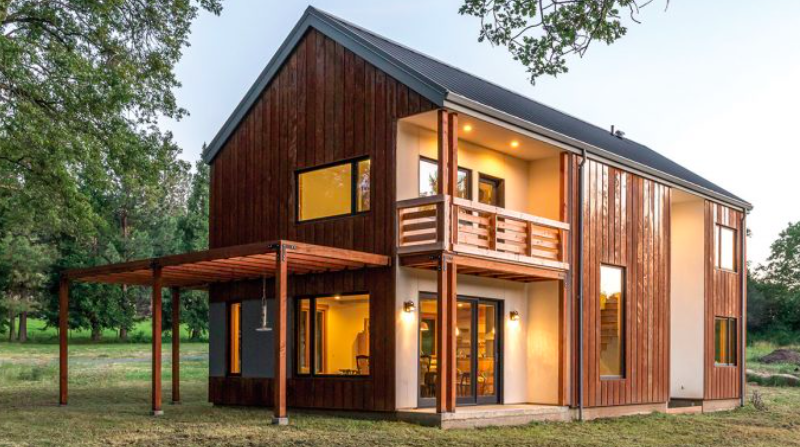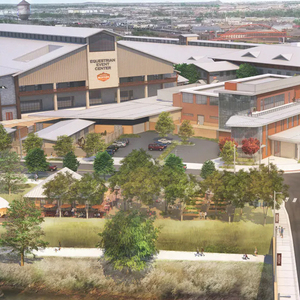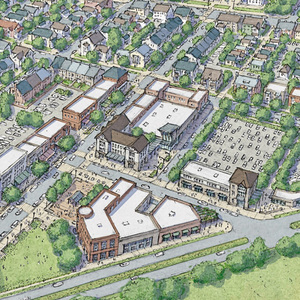
America’s electricity grid is old and inefficient. Organizationally and functionally, it’s become a cat’s cradle gone awry. And in many parts of the country, where renewable wind and solar energy infrastructure is proliferating, the grid is being asked to perform tasks it wasn’t designed to do. In theory, new communities and growing populations should reasonably translate into a bigger, stronger grid (with hardened transmission lines, grid-scale energy storage capacity, and the like), but our very notion of “resiliency” is being tested in ways previously unfathomable. Each passing heat wave, wildfire, and extreme weather event provides a grim reminder of just that.
So, what’s to be done with this mishegoss? Arguably, expanding and hardening the entire operation—which is neither exclusively a jurisdictional matter for states nor the federal government but rather a joint concern—is a suitable half measure to improve resiliency and security over the short term. But a truly modernized grid must be more than a patchwork of new hardware and technologies that’s been slapped onto the existing system. Rather than a bloated version of what came before, a modern grid for the 21st century is flexible, decentralized, and small. In short, it isn’t one big grid but a composite of smaller grids that are both tied to and independent of the larger system. That just leaves the question, what does this look like at the community scale?
A model community
Last month, the community of Fairmount Heights, in Prince George’s County, Maryland, broke ground on a new development of six zero-energy ready, single-family homes—slated for completion summer 2024—that will be available to first-time homebuyers earning 80% or less of PG County’s median income (which is $120,550 for a four-person household). This new community, however modest, is a development model worth replicating. The homes are efficient, self-sustaining, affordable, and, in a first for the region, connected to a microgrid.
The use of a microgrid system is also new for the homes’ developer, the non-profit Housing Initiative Partnership (HIP). “This hasn’t been done in Maryland before,” says Stephanie Prange Proestel, HIP’s deputy director. “Once we found out this was a viable option to move forward, we applied to the Maryland Energy Administration (MEA), and they provided [grant] funding specifically for the microgrid. It’s a big investment from all [project] partners to make this happen.” (In 2022, the MEA launched the Resilient Maryland Capital Development Pilot Program, which provides funds to communities, organizations, utilities, and other entities to help develop comprehensive microgrid systems.)
While microgrids and similar energy distribution systems have gained traction in recent years, and are even highlighted by the U.S. Department of Energy as viable measures toward achieving grid resiliency, they remain expensive pursuits and thus are typically reserved for high-income communities. Fairmount Heights is breaking the mold, in many respects, by pioneering this technology at the affordable housing scale. “Fairmont Heights has always been very interested in green and has been working toward reaching a certification called Sustainable Maryland,” Proestel says.
Fairmount Heights is a small community of about 1500 people, but one with “a rich history,” according to Proestel. As the second established African American Township in PG County (it was incorporated in 1935), the town and many of its buildings received designation, in 2011, by the National Trust for Historic Preservation and the National Register of Historic Places. And in 2018, its mayor and town council dedicated the Fairmount Heights African American Signage Trail, which features various markers that identify historic sites and resources. A portion of the trail extends through this housing development and will touch on a critical nexus within a new neighborhood pocket park that’s being developed in tandem with the single-family homes.
Affordable and zero-energy design
The homes’ design is courtesy of Peabody | Fine Architects, based in Alexandria, Virginia, a regional leader in Passive House design and zero-energy buildings. According to principal Matthew Fine, the feasibility of building six identical high-performance homes on a single parcel was never in question. What was in question, however, was achieving such a feat “at an affordable level.”
The homes themselves are “fairly modest” and “contextually appropriate,” Fine says. At about 1700 sq. ft. apiece, the 3-bed, 2-1/2-bath houses feature open floor plans at ground level, which helps with daylighting and ventilation, and crawlspace foundations. And naturally, the buildings are optimally sited for maximum solar gain.
According to the architecture firm’s website, “Up until now, net-zero-energy buildings have been rare and expensive. This is primarily because they are not designed in an integrated way; solar panels are simply added, at considerable cost, to buildings built at or slightly above energy code minimums. This is not a viable approach in bringing net zero to the affordable housing sector.” In the case of Fairmount Heights, HIP had the unique ability—as both a developer of affordable housing and purveyor of HUD-certified homebuyer counseling programs—to find the necessary funding to make this project a reality, which it did in the form of MEA grant.
That said, the entire process, from design development to groundbreaking, was anything but smooth. Fine recalls an early feasibility study that effectively killed the project. “The conclusions of that study were that … this would be difficult and expensive. And it just kind of ended there.” But the project’s stakeholders dug in, convinced there was a way and the means. The means arrived courtesy of a visionary and determined developer; the way came from an energy company with deep experience in building microgrids.
Returning to direct current
“We all know we need a lot more energy, clean energy and, and that we’re going to use electricity in ways that we’ve really never used it before,” says Rob Bennett, CEO of Tampa, Florida-based Block Energy.
In what amounts to a blockchain of battery boxes, Fairmount Heights’s microgrid—designed by Block Energy and purchased by local utility provider Pepco—is a shared energy network comprising six rooftop PV arrays and six BlockBoxes that collect, store, and manage power sharing throughout the community. “When we looked at the concept of breaking the power grid up into smaller pieces, it makes a lot of sense,” Bennett says. “And if you can manage those pieces independently of the main grid and only interact with it in ways that are constructive for the grid, and for the local community, then the whole system can work together.” He adds, “solar panels and modern battery storage and modern power electronics and modern controls all allow us to do that in ways that were never possible [over] 100 years ago, when Tesla and Edison were having their debate about the best way to build a power system.”
Bennett citing the two main principals of the so-called “War of the Currents” is no accident. Thomas Edison, of course, was convinced that direct current (DC) power, which runs continually in one direction, was the superior method. And in fact, when America’s grid was in its infancy, DC was the standard. It was also expensive and inflexible. Enter Nikola Tesla, George Westinghouse, and the ensuing dominance of alternating current (AC), which proved cheaper and more easily convertible to different voltages with the help of a transformer.
Nowadays, while most of our electricity is AC-powered, computers, televisions, VRF heat pumps, EVs, solar cells and batteries, and even newer refrigerator models all run on DC power, hence the brick-like converters that typically complement your laptop’s power cord and other devices, which end up wasting a lot of energy. Block Energy’s microgrid—which is being deployed for the first time in an affordable housing community—gets around this issue in an innovative way.
“The direct current technologies really have an advantage, and that’s how we’ve designed our system,” Bennett says. “It has an interface that connects to the AC grid to interact with the utility. And when we get to your home, we take this DC energy and we turn it back into AC right at your meter. We give you absolutely perfect alternating current energy because that’s what your home wants.
“People don’t think about it a lot,” he continues, “but every time a new community gets built … with 3000 homes and the Walmart and everything else that goes with it, these add a lot to the electrical load. So, at some point you need to build new power plants and new transmission lines and new substations. And it’s expensive. It takes a lot of time and it’s complicated. But you can meet the energy needs of these communities by building infrastructure right in the community. This avoids the need to do all those other system upgrades and that’s proven to be cheaper for the utilities.”
For the time being, Fairmount Heights will have to suffice as an outlier. “Every new home that gets built should have solar on it. That’s a pretty practical idea,” Bennett says. All the same, sound logic must contend with a green building and energy market that, as of now, is ill-equipped to accommodate an influx of new affordable housing stock. High praise is due to Housing Initiative Partnership and the larger team that made Fairmount Heights even possible, but until this development model can be replicated at the 3000-home scale, as opposed to six, affordable and efficient housing will remain the product of creative problem solving rather than the status quo. That’s a shame.
________________________________________________________________________
Justin R. Wolf is a Maine-based writer who covers green building trends and energy policy. Image courtesy Housing Initiative Partnership.
Weekly Newsletter
Get building science and energy efficiency advice, plus special offers, in your inbox.















6 Comments
"But you can meet the energy needs of these communities by building infrastructure right in the community. "
15 years back I took a basic class in the design of rooftop PV systems, just out of curiosity. We had to do a "project". So I looked at the vast flat rooftop of the local shopping mall and did a schematic design for a PV system on it. It provided enough capacity to power 3000 homes. Shade/rain structures over the parking lot could have provided a similar amount more, but of course at higher cost.
I'm sure opportunities like this exist all over the country if we can do a better job of identifying them and making them feasible.
“ solar panels are simply added, at considerable cost, to buildings built at or slightly above energy code minimums. This is not a viable approach in bringing net zero to the affordable housing sector.”
Interesting take from the architect. If a 5kw array can be had for ~$15k pre subsidy, what is the cheaper way to get to net zero?
Imagine how much cheaper net zero would be if PG county was friendlier to multi-family housing or new row houses.
"And when we get to your home, we take this DC energy and we turn it back into AC right at your meter."
How is this better than converting to AC at the source/box and sending to the homes? AC is MUCH easier and more reliable to do circuit breakers. Plus the issue of stepping voltage up/down doesn't go away. This seems like a terrible solution.
How much step up/step down do you anticipate? As a residential system I’d expect it all to be two phase 240v for everything.
I believe the microgrid includes battery storage as a key component; DC is necessary to charge and use battery energy.
Also I can see improvements in residence electric energy management to minimize waste and even risk, including lower voltage and DC such as for simpler, more durable and cheaper LED lighting.
It will be interesting to see how successful this model is outside of a pilot project subsidized with grants. The suburbs around DC are full of McMansions that are huge and poorly built. It's what seems to sell, or what developers have convinced buyers what they want.
The area also has a higher turnover rate due to government and military. There is joke about banner earnings for real estate agents every four years. More transient buyers are less willing to pay for longer term returns on their houses.
Log in or create an account to post a comment.
Sign up Log in